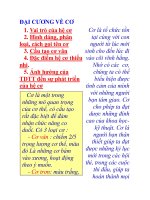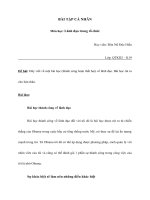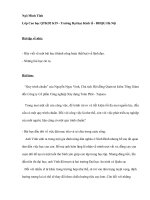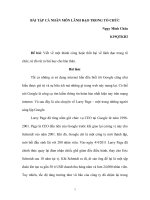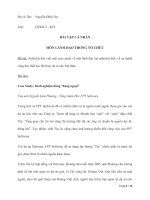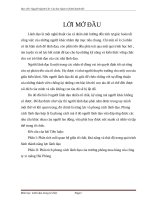Slide đại cương về lãnh đạo trong tổ chức chapter 5 communication, coaching and conflict skills
Bạn đang xem bản rút gọn của tài liệu. Xem và tải ngay bản đầy đủ của tài liệu tại đây (18.03 MB, 72 trang )
LEADERSHIP:
ng
.c
om
Theory, Application, Skill
Development
co
2d Edition
ng
th
an
Robert N. Lussier
and Christopher F. Achua
du
o
This presentation edited and enhanced by:
cu
u
George W. Crawford
Asst. Prof. of Mgmt.
Clayton College & State University
Morrow, GA 30260
Copyright ©2004 by South-Western, a division of Thomson Learning. All rights reserved.
CuuDuongThanCong.com
5-1
/>
co
ng
.c
om
Chapter 6
cu
u
du
o
ng
th
an
Communication,
Coaching, and
Conflict Skills
Copyright ©2004 by South-Western, a division of Thomson Learning. All rights reserved.
CuuDuongThanCong.com
5-2
/>
.c
om
Chapter 4
Learning Outcomes
cu
u
du
o
ng
th
an
co
ng
• Oral message sending process
• Three parts of message receiving
process
• Paraphrasing
• Feedback
• Coaching model
• 5 Management conflict styles
• Conflict resolution model
Copyright ©2004 by South-Western, a division of Thomson Learning. All rights reserved.
CuuDuongThanCong.com
5-3
/>
.c
om
cu
u
du
o
ng
th
an
co
ng
What is Communication?
Copyright ©2004 by South-Western, a division of Thomson Learning. All rights reserved.
CuuDuongThanCong.com
5-4
/>
.c
om
What is Communication?
cu
u
du
o
ng
th
an
co
ng
• Communication is the process of
conveying information and
meaning
• Effective communication involves
the ability to transmit and
receive information with a high
probability that the intended
message is passed from sender
to receiver
Copyright ©2004 by South-Western, a division of Thomson Learning. All rights reserved.
CuuDuongThanCong.com
5-5
/>
.c
om
What is Communication?
cu
u
du
o
ng
th
an
co
ng
• The sharing of information
between individual or groups
to reach a common
understanding in order to
accomplish organizational
goals and objectives
Copyright ©2004 by South-Western, a division of Thomson Learning. All rights reserved.
CuuDuongThanCong.com
5-6
/>
cu
u
du
o
ng
th
an
co
ng
.c
om
Is Communication an
Important Leadership
Skill?
Copyright ©2004 by South-Western, a division of Thomson Learning. All rights reserved.
CuuDuongThanCong.com
5-7
/>
.c
om
Is Communication an
Important Leadership
Skill?
cu
u
du
o
ng
th
an
co
ng
• Effective leaders are effective
communicators
• Organizations with effective
communications systems are
more likely to be successful
• An important part of a
manager’s job is to give
instructions
Copyright ©2004 by South-Western, a division of Thomson Learning. All rights reserved.
CuuDuongThanCong.com
5-8
/>
cu
u
du
o
ng
th
an
co
ng
.c
om
When you want to send
a message, what is the
first step you should
take?
Copyright ©2004 by South-Western, a division of Thomson Learning. All rights reserved.
CuuDuongThanCong.com
5-9
/>
ng
th
an
co
ng
.c
om
When you want to send a
message, what is the
first, very important,
step you should take?
cu
u
du
o
Plan the Message
Copyright ©2004 by South-Western, a division of Thomson Learning. All rights reserved.
CuuDuongThanCong.com
5-10
/>
cu
u
du
o
ng
th
an
co
ng
.c
om
What Messages Should
a Leader Plan?
Copyright ©2004 by South-Western, a division of Thomson Learning. All rights reserved.
CuuDuongThanCong.com
5-11
/>
.c
om
What Messages Should
a Leader Plan?
th
ng
du
o
• On paper
an
co
– Oral, face-to-face
– Oral, telephone
– Written
ng
• All Messages
cu
u
• Then review and edit or practice
ã The activities will greatly enhance
communications effectiveness
Copyright â2004 by South-Western, a division of Thomson Learning. All rights reserved.
CuuDuongThanCong.com
5-12
/>
u
du
o
ng
th
an
co
ng
Purpose of message (goal)?
To whom (receiver)?
How (media)?
When (timing)?
Where (setting)?
cu
•
•
•
•
•
.c
om
Plan Your Messages
– Limit distractions (called noise)
Copyright ©2004 by South-Western, a division of Thomson Learning. All rights reserved.
CuuDuongThanCong.com
5-13
/>
Oral Message Sending Process
.c
om
Develop Rapport
an
co
ng
State Communication Purpose
Check Understanding
cu
u
du
o
ng
th
Transit Message
Get Commitment / Follow Up
Copyright ©2004 by South-Western, a division of Thomson Learning. All rights reserved.
CuuDuongThanCong.com
5-14
/>
cu
u
du
o
ng
th
an
co
ng
.c
om
Who Has the Primary
Responsibility to Ensure
that a Message is
Understood?
Copyright ©2004 by South-Western, a division of Thomson Learning. All rights reserved.
CuuDuongThanCong.com
5-15
/>
ng
.c
om
Who Has the Primary
Responsibility to Ensure that
a Message is Understood?
co
• The sender
ng
th
an
– Knows what the message is
supposed to convey
cu
u
du
o
• But this doesn’t let the
receiver off the hook
– Must do everything possible to
understand received messages
Copyright ©2004 by South-Western, a division of Thomson Learning. All rights reserved.
CuuDuongThanCong.com
5-16
/>
Analyzing
•Pay attention
•Think
an
•Paraphrase
•Watch nonverbals
du
o
•Don’t interrupt
Check
Understanding
ng
•Stay tuned in
•Evaluate after
listening
th
•Avoid distractions
co
ng
Listening
.c
om
Message Receiving
Process
•Take notes
cu
•Ask questions
u
ãWatch nonverbals
ãConvey meaning
Copyright â2004 by South-Western, a division of Thomson Learning. All rights reserved.
CuuDuongThanCong.com
5-17
/>
.c
om
Don’t Forget to Analyze
cu
u
du
o
ng
th
an
co
ng
Analyze what?
Copyright ©2004 by South-Western, a division of Thomson Learning. All rights reserved.
CuuDuongThanCong.com
5-18
/>
.c
om
Don’t Forget to Analyze
ng
cu
u
du
o
– Words
– Numbers
– Graphs
th
an
co
ng
• Think about the message
ã Translate it from symbols to
thought
ã Analyze and Evaluate
Copyright â2004 by South-Western, a division of Thomson Learning. All rights reserved.
CuuDuongThanCong.com
5-19
/>
cu
u
du
o
ng
th
an
co
ng
.c
om
What is the Most
Powerful Method to
Ensure that Messages
You Send are
Understood?
Copyright ©2004 by South-Western, a division of Thomson Learning. All rights reserved.
CuuDuongThanCong.com
5-20
/>
th
an
co
ng
.c
om
What is the Most
Powerful Method to
Ensure that Messages
You Send are
Understood?
cu
u
du
o
ng
• Ask the receiver(s) to
paraphrase
– What in the world is
“paraphrase”?
Copyright ©2004 by South-Western, a division of Thomson Learning. All rights reserved.
CuuDuongThanCong.com
5-21
/>
Paraphrasing
cu
u
du
o
ng
th
an
co
ng
.c
om
the process of
having the
receiver restate
the message in
his or her own
words to ensure
that
communication has
taken place
Copyright ©2004 by South-Western, a division of Thomson Learning. All rights reserved.
CuuDuongThanCong.com
5-22
/>
2 Common Approaches to
Getting Feedback
cu
u
du
o
ng
th
ng
• Give the
entire
message
followed by
asking “Do you
co
an
• Send the
entire message
and assume it
has been
conveyed with
mutual
understanding
.c
om
(and why they don’t work)
have any
questions?”
Copyright ©2004 by South-Western, a division of Thomson Learning. All rights reserved.
CuuDuongThanCong.com
5-23
/>
.c
om
ng
ng
th
an
co
Receivers are ignorant
Reluctance to point
out sender’s ignorance
cu
u
du
o
4
Reasons
Why
People
Do Not
Ask
Questions
Receivers feel ignorant
Copyright ©2004 by South-Western, a division of Thomson Learning. All rights reserved.
CuuDuongThanCong.com
Receivers have
cultural barriers
5-24
/>
.c
om
Paraphrasing Helps to
Resolve These Problems
ng
th
an
co
ng
• There will still be problems
• But when paraphrasing is
done correctly
cu
u
du
o
– communication effectiveness
improves drastically
Copyright ©2004 by South-Western, a division of Thomson Learning. All rights reserved.
CuuDuongThanCong.com
5-25
/>
